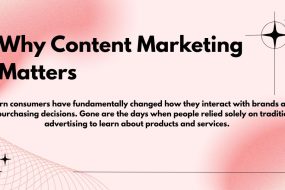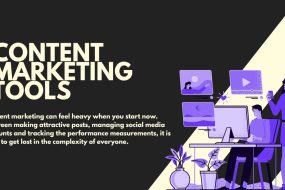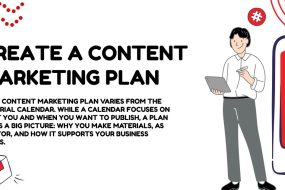
Content marketing has become the backbone of modern digital marketing strategies. But what does it really make it so effective, and how can the business use your power to carry out meaningful results?
In the core, material marketing is a clear, strategic construction and distribution of valuable, relevant material designed to attract and attract a clearly defined audience. Unlike traditional advertising, which prevents consumers, material marketing provides fair value, while guiding potential customers through the purchase journey.
This wide guide material will detect the mechanics of marketing, it will explain why it works so well, and provides action -rich strategies to help you create a successful material marketing program from the ground.
What Makes Content Marketing So Effective?
Material marketing is successful because it matches how modern consumer prefers to detect and research products or services. Instead of being sold, people want to be educated, entertained and motivated.
When right, content marketing gives trust between your brand and the audience. You become a reliable source of information, not just another company trying to sell. This confidence is translated into strong customer relationships and finally better business results.
The efficiency also stems from the marketing material’s ability to provide value at all stages of customers’ journey. Whether someone is aware of the problem or is ready to make a purchase decision, they can find strategic materials where they are.
The Content Marketing Ecosystem

Content Creation
The foundation of any content marketing strategy starts with creating high-quality, valuable content. This content takes many forms:
Blog posts and articles remain the most popular content format, offering detailed information that helps solve problems or answer questions. They’re particularly effective for improving search engine visibility and establishing thought leadership.
Video content has exploded in popularity, with platforms like YouTube, TikTok, and Instagram driving massive engagement. Videos can explain complex concepts, showcase products, or provide entertainment value.
Infographics and visual content help break down complicated information into digestible, shareable formats. They’re especially useful for data-heavy topics or step-by-step processes.
Podcasts have created intimate connections between brands and audiences, allowing for deeper conversations and building stronger relationships over time.
Social media posts provide quick, frequent touchpoints with your audience, keeping your brand top-of-mind and encouraging ongoing engagement.
Distribution Channels
Creating great content is only half the battle. Getting it in front of the right people requires strategic distribution across multiple channels.
Owned media includes your website, blog, email newsletter, and social media profiles. These channels give you complete control over your message and audience experience.
Earned media occurs when others share your content organically. This might include social media shares, mentions in other publications, or word-of-mouth recommendations.
Paid media amplifies your content’s reach through advertising platforms like Google Ads, Facebook Ads, or sponsored content on relevant websites.
Audience Engagement
Successful content marketing creates genuine connections with your audience. This happens through storytelling, addressing real pain points, and providing practical solutions.
Engagement metrics like comments, shares, time spent on page, and click-through rates help measure how well your content resonates with your target audience. High engagement signals that your content is valuable and worth consuming.
The Content Marketing Funnel
Content marketing works by guiding potential customers through a structured journey from awareness to purchase and beyond.
Top of Funnel: Awareness Stage
At this stage, people are just becoming aware of a problem or opportunity. Your content should be educational and helpful without being overly promotional.
Blog posts that answer common questions, how-to guides, and industry insights work well here. The goal is to provide value while introducing your brand as a knowledgeable resource.
Middle of Funnel: Consideration Stage
Once people understand their problem, they begin researching potential solutions. Your content should help them evaluate different options and understand what makes a good solution.
Comparison guides, case studies, webinars, and detailed product information help prospects make informed decisions. You can be more specific about your offerings while still focusing on education.
Bottom of Funnel: Decision Stage
When prospects are ready to buy, your content should address final concerns and provide the information needed to choose your solution.
Customer testimonials, free trials, product demonstrations, and detailed pricing information help close the deal. This content removes barriers to purchase and builds confidence in your solution.
Post-Purchase: Retention and Advocacy
Content marketing doesn’t end with a sale. Ongoing content helps customers get maximum value from their purchase and can turn them into advocates for your brand.
User guides, best practices, success stories, and community building all contribute to long-term customer satisfaction and loyalty.
Key Content Marketing Strategies
Search Engine Optimization (SEO)
Creating content that ranks well in search engines provides a steady stream of organic traffic. This involves researching keywords your audience searches for and creating comprehensive, helpful content around those topics.
Telehealth SEO-focused content marketing requires understanding search intent and creating content that genuinely answers what people are looking for. Technical factors like page speed, mobile optimization, and proper heading structure also play important roles.
Social Media Integration
Social media platforms offer unique opportunities to share content and engage with your audience. Each platform has its own culture and best practices, requiring tailored approaches.
LinkedIn works well for B2B content and professional insights. Instagram and TikTok excel at visual storytelling and reaching younger audiences. Twitter facilitates real-time conversations and industry discussions.
Email Marketing
Email remains one of the most effective ways to distribute content directly to interested subscribers. Newsletter campaigns, automated sequences, and personalized content recommendations help nurture leads over time.
Successful email content marketing requires building a quality subscriber list and consistently delivering value. This might include exclusive content, early access to resources, or curated industry insights.
Influencer Partnerships
Collaborating with influencers and industry experts can amplify your content’s reach and credibility. These partnerships might involve guest posting, co-created content, or having influencers share your existing content.
The key is finding influencers whose audiences align with your target market and whose values match your brand. Authentic partnerships perform better than purely transactional relationships.
Read our latest blog Content Marketing Tools
Measuring Content Marketing Success

Effective content marketing requires tracking the right metrics to understand what’s working and what isn’t.
Engagement Metrics
Time on page, bounce rate, social shares, and comments indicate how well your content resonates with your audience. High engagement suggests your content is valuable and worth consuming.
Traffic Metrics
Organic search traffic, referral traffic, and direct traffic show how well your content attracts new visitors. Growing traffic indicates your content is reaching more people over time.
Conversion Metrics
Email signups, download completions, and sales directly attributed to content show how well your content drives business results. These metrics connect content efforts to revenue outcomes.
Brand Awareness Metrics
Brand mention tracking, search volume for your brand terms, and survey data about brand recognition help measure content marketing’s impact on overall brand awareness.
Common Content Marketing Challenges
Consistency and Scale
Creating high-quality content consistently requires significant time and resources. Many businesses struggle to maintain regular publishing schedules while ensuring content quality.
Planning content calendars, repurposing existing content, and building efficient content creation processes help address these challenges.
Measuring ROI
Content marketing benefits often take time to materialize, making it difficult to measure immediate return on investment. Building comprehensive tracking systems and focusing on leading indicators helps demonstrate value.
Competition for Attention
The volume of content being published daily makes it increasingly difficult to stand out. Success requires creating truly exceptional content that provides unique value or perspectives.
Keeping Up with Changes
Digital platforms, algorithms, and consumer preferences constantly evolve. Staying current with best practices and platform updates requires ongoing education and adaptation.
Building Your Content Marketing Strategy
Start by clearly defining your target groups and understanding their needs, preferences and challenges. This basis indicates all other material marketing decisions.
Set the average average target for content marketing measures. Whether you aim to increase brand awareness, generate potential customers or run sales, supervisor Clear Goals your strategy and measurement approach.
Develop a material calendar that balances different types of materials and distribution channels. Constant publishing creates expectations of the audience and the search engine improves visibility.
Make high quality materials that actually help the audience. Be aware of solving real problems rather than marketing your products or services directly.
Distribute your content to many channels to maximize access. Do not rely on the same platform or distribution method.
Your Next Steps in Content Marketing
The material works by building the marketing fection, providing value and leading the possibilities through the purchase journey. For success, it is necessary to consistent effort, strategic thinking and real focus on meeting the needs of the audience.
Start in small with one or two types of materials and distribution channels. Master these basic things before expanding more complex strategies. Focus on creating a really useful material that addresses the real problems of the audience.
Remember that material marketing is a long -term strategy. While some benefits quickly appear, the most important results usually develop for months or years of persistent effort.
Companies that succeed in material marketing are those who are committed to serving their audience and selling the other. When you provide real value through your content, business results naturally follow.


















No Comments